There I was, two weeks ago. Standing 10 feet upstream of one of the biggest rainbow trout I’ve ever seen. Had he seen me? Was he feeding? Even if he took my fly, did I have a chance of landing him in this small Georgia stream?

I’ve always been intrigued by the Soque River, which is nestled in the foothills of Habersham County, Georgia, even before I began fly fishing. The Soque (pronounced “so KWEE”) first began attracting attention in the 1980s when CNN founder Ted Turner bought several miles of property along the river for exclusive fly fishing access for his celebrity friends. It didn’t take long for it to become the glamour fly fishing river in Georgia.
Before social media existed, pictures of giant trout from the Soque began appearing in sportsmen’s magazines. Property for sale with Soque River frontage became as scarce as hen’s teeth. A half dozen lodges built along privately-owned stretches of the river offered the trout of a lifetime to those who had plenty of money and didn’t care that their trophies were grain-fed.
Right smack dab in the middle of all these private fishing resorts is a half-mile stretch of the river that’s available to the public. As you can imagine, it’s a popular place among the locals. The Georgia Department of Natural Resources fills this public fishing area weekly with SNITs (stocked nine-inch trout) during the spring and summer. The catch-and-keep crowd cleans this section out as quickly as the trout are put in.
Back in my spincast days when I lived in Georgia, I’d visit the public section about once a summer to show my prowess over the Soque and its SNITs, knowing that there was always a possibility of catching a wayward monster from the nearby fish-fattening-up farms. As a dedicated bait fisherman, I shamelessly fished it with salmon eggs, nightcrawlers, crickets, Powerbait, and Green Giant Nibblet corn, usually coming home with a stringer full of SNITs.
After I began fly fishing, I still went to the public area of the Soque occasionally, but felt like I was at a disadvantage to the bait fishermen and their scented offerings. The final straw for me was one summer afternoon 15 years ago when I was successfully fishing a run, and heard a loud vehicle approach the nearest pull-off to where I was fishing. Four car doors slammed, and soon thereafter, five teenagers with spinning rods and cans of worms came running down the trail to my pool. Before I knew it, I was surrounded by kids casting into the pool in which I was fishing. At that point, I decided that fishing the Soque was no longer for me.

About the time that I moved to the Boston area nine years ago, my daughter and her husband moved to Habersham County, living about 15 minutes from the Soque. My wife and I usually visit them two or three times a year, and fishing is always on the agenda. There are numerous trout streams within an hour’s drive; it is truly a haven for fly fishermen.
In late December this year while on vacation in Georgia, after fishing familiar stretches of the Chattooga and Chattahoochee Rivers, I began wondering if a short trip to the Soque would be worthwhile. I knew that Labor Day weekend was the last time it had been stocked, and the vast majority of the SNITs were no longer in the river but stockpiled in the freezers of the local fishermen.
Very few people fish the public section of the Soque in the winter, but local legend has it that giant trout from the private stretches feel the primal need to migrate when the water gets cold and pass through the public section. There were enough apocryphal stories of a third cousin, half-removed, who had caught a 32-incher or grainy photos of large colorless trout lined up on the bank to place the veracity of this rumor somewhere between that of the questionable existence of Big Foot and the plausibility of voter fraud during the 2020 election.
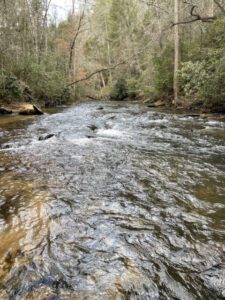
So…I decided to go fishing in the Soque in late December and see if I could add to the rumors.
In my humble opinion, the Soque River, particularly the public area, is not the most picturesque of trout streams. Though thick patches of mountain laurel shade the river and keep it cool during the summer, the banks and river bottom are white clay that muddies quickly in a rain shower. The river doesn’t have much elevation change or many bends. It could also use some more deep pools and pocket water. But I quibble.
I parked my vehicle in the parking lot at the downstream end of the public fishing section, marked by the George Carter Jackson Bridge. It had been a while since the area had received rain, and the river was low and very clear. I decided to use a dry/dropper set-up to be as stealthy as possible.
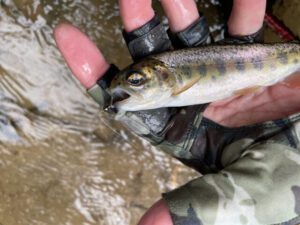
On the fifth cast, as I was working my way upstream, my stimulator paused, and I set the hook on a six-inch rainbow with parr marks. This was a pleasant surprise. I figured that I might have a chance at catching a holdover SNIT or two, but I never considered that there might be some stream-bred trout in the river. I caught three more similar rainbow on my size 14 soft hackle pheasant tail over the next 250 yards.
I reached a languid stretch of the river and decided to walk back to my car and drive further up Highway 197 to the upper end of the public section. I’d never fished that end of the public access area and wanted to give it a try. I noticed that the trail to the river kept turning towards the private area and wondered if this trail had been cut by unscrupulous fishermen who yearned for the giant trout of the private access area. The trail came to the river right at the public/private border.
There were signs threatening prosecution for anyone who fished in the privately-owned section of the river. Even so, I have to admit it was tempting. What would a few innocent casts up there hurt? Who would know? In the end, I decided that the value of my integrity was worth more than a few casts into forbidden waters.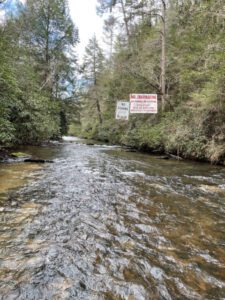
The pools at that end of the public section seemed a little longer and deeper than the area that I had just left. I was working my way downstream when I saw a long dark shadow in the middle of a long, sand-covered run in about two feet of water. It was slowly making its way back and forth across the sandy run. There was no doubt it was a trout, and there was no doubt that it was at least 30 inches. It had to be an escapee from Turner’s trout paradise.
Since I was working my way downstream, and since I was standing about 10 feet in front of the rainbow’s snout, I couldn’t have felt any more exposed if I were standing there naked. What do I do now? If I move, I’ll spook him. I was already thinking about how catching this trout would make a great article for the blog.
I very slowly eased my way back towards the bank, though I was still upstream of him. The thick mountain laurel prevented me from getting on the bank. I chanced a very unobtrusive roll cast to get my dry/dropper rig in the current in front of the behemoth. Maybe the trout would be hungry and easy. But the fly passed right by it, and the trout acted like it didn’t notice it. I tried again, same result. At least it didn’t take off and leave me.
I decided to try to move downstream of the trout so I could cast upstream to it without it seeing me. Using advanced trout psychology, I turned my face away from the trout so it would think that I wasn’t interested in it as I slowly waded downstream of it.
Parenthetically, this is the same psychology I used on girls in high school. By acting not interested in them, it was easier to handle the rejection that I would have received if I had acted interested. This is deep stuff, and I wouldn’t expect all but the most knowledgeable blog readers to be able to understand it.
The only outcome of my decision to break eye contact with Sir Trout was that when I got downstream of him and turned around to cast to him, I couldn’t locate him. He had moved. No doubt he had done so with his eyes averted so as to act like he wasn’t aware of my presence. This was a cagey trout, a worthy opponent in this high-stakes game of conquer or be conquered.
Eventually, I located him against the far bank where the water was about a foot deep. I changed my dropper fly to a size 22 JuJu Baetis and made several casts wherein the trout simply pretended not to care. I passed it off as just in keeping with his total disconcerting air. (Name that tune in the comments section)
At that point, I needed to regroup and think carefully about how to approach this trout. Come on, Bill! How does a trout think? What is he looking for? Then it hit me. Of course! Anyone with an ounce of piscatorial acumen would see it immediately. He’s looking for trout pellets like he gets every day from the electronic feeders upstream. Man, it is so helpful when you learn to think like a trout.
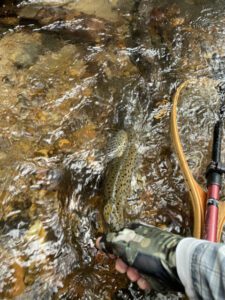
I had an old brownish/reddish egg pattern that sort of resembled the size and shape of a grain pellet. I tied it on and looked up. The monster rainbow was gone. I waited around for about five minutes, but he never showed up.
But who was I kidding? I had as much of a chance of catching that trout as I did of my high school’s homecoming queen asking me for a date. It wasn’t going to happen, but one can always dream.
I changed my dropper fly back to the soft hackle pheasant tail and walked downstream to the next promising run. As the fly was drifting about four feet in front of me, I saw a swirl and watched as my indicator took off upstream. At first, I thought the trout was a medium-sized holdover, but as it began to take line, my hopes began to rise.
I played that trout for what seemed like five minutes in that pool without ever getting a good look at him. He was staying deep and in the shadows. The ache in my forearm as he went for run-after-run made me realize I was in for a prolonged fight.
At some point, the trout decided to use the current to his advantage and took off downstream with my drag screaming. I was using 6x tippet, so I decided to follow him downstream rather than trying to horse him back up to me. I played him for a minute at the next pool, and then he took off downstream to the next pool. This re-occurred three times in downstream pools.
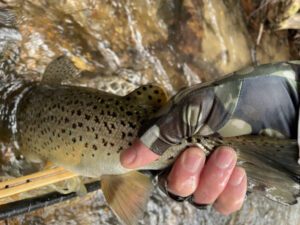
I finally got a good look at him and saw that he was a beautiful brown trout. Not as long or fat as the rainbow I had seen earlier. But he had the athletic shape of a wild trout, unlike the bloated, pellet-fed rainbows normally associated with the Soque.
Eventually, he went into some shallow water near the bank. As I was trying to net him, my rod tip got tangled in a mountain laurel bush with the brown trout thrashing about 10 feet downstream. I left the rod stuck in the bush and went down and netted the trout. You do what you gotta do.
The trout was doubled over in my fifteen-inch net opening, and as I was trying to extricate the hook, my heart sunk. The nymph hook was buried into the flank of the trout – foul-hooked. I will go to my grave believing that he was lip-hooked in that first pool. He played just like a properly hooked fish. Then somehow, the hook slipped out and stuck in behind his gill plate, and he began making his runs downstream.
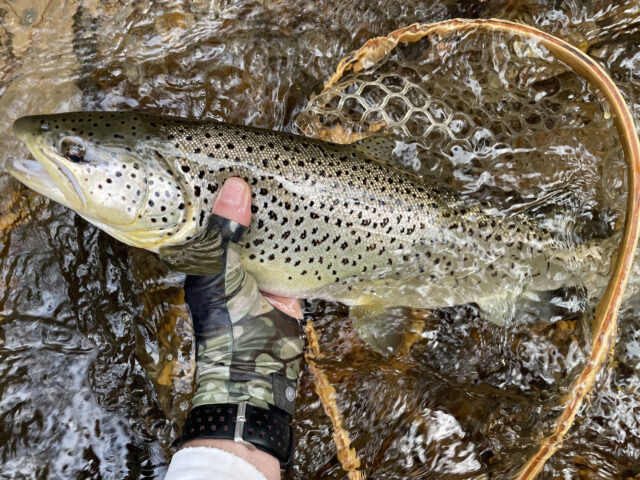
I taped him to be 20.5 inches. I wanted to get some good pics, but I couldn’t hold the camera with one hand and the trout with the other. He was too big to get my hand around and was too feisty to sit still in shallow water for a photo. I did my best to keep him in the water and get a pic or two of him.
He didn’t need any reviving, but I held him in the water for a while to be sure. I thanked him for his trouble and bid him adieu. I felt great! The homecoming queen runner-up had just asked me for a date.
Discover more from BlogFlyFish.com
Subscribe to get the latest posts sent to your email.

Bill, great story as always but…. I would have thrown my gloves in the river and lost them before grabbing that beautiful brown with them on. I’m sure your mind set was not on your gloves but other readers might not be as nice as me.. tight lines my friend.
Steve, I appreciate your comment and your concern for the well-being of the trout. I was using the Simms Solarflex Sun Gloves to protect my hands from sun exposure. They are 92% polyester/8%spandex and very thin. They also have a cut out palm area. I didn’t think of them as harmful to the trout because they are slicker than my hands are when it comes to gripping fish. I even have to take them off when they are wet to get a grip on the steering wheel of my car. I did a quick Google search to see if using them to handle trout will harm the fish, but I didn’t come up with anything. I’d be interested in seeing if there is anything definitive regarding using these sun gloves to handle fish, either one way or the other. In the meantime, I’ll make it a point to remove the gloves when handling trout. Thanks for your friendly rebuke. “Faithful are the wounds of a friend; profuse are the kisses of an enemy.” Proverbs 27:6
Great write-up on a great homecoming date and stream side dance! Congrats.
Thanks, Jeff. Now that you mention it, there isn’t much difference between the way I stumbled down the river with that brown trout and the way I danced at homecoming.
Bill, now I’m curious myself about the harm they may or may not cause.. IV been told by some reputable guides that there no good as the slime still sticks to the material more than skin or nitrile gloves. I have the same gloves in a few styles of finger lengths and always end up one gloving it after first fish.. so after many times trying to rip them off IV just stopped using them. IV gone to the solar flex long sleeve with thumb straps that protect the backs of your hand and still doesn’t touch the fish. Just one more way to try to do my part.. and again, love your stories bill.
Regards
Steve
It’s a small sacrifice to pull a glove off before handling a fish if it means saving the fish from harm. I like your thumb-strap alternative and will give it a try.
Truth be told, I’d just as soon not take photos of the fish I catch. If it isn’t enough to deal with my rod, my net, the fish, the hooks, and my gloves, there’s the fight with my wading belt to fetch the camera from my pants pocket. Besides, I have more pictures of trout than I do of my grandkids. But taking pics is as necessary in blogging as it is in homecoming dances. I need to learn some better methods of taking pics when the fish are too big for one hand – in case I ever happen to catch another one.
Thanks for doing your part and encouraging me to do mine as well.
Bill
Bill, what a nice gift you have shared with us! Cleverly written, effectively informative, and fun to read as well…
Thanks, Fred!
Sounds good bill, one more tip.. if you have an I phone you can reverse the pic and set a timer for self portraits.. took me a while but IV gotten pretty good at it as long as your close to the edge of the river to set up the phone. I don’t bring a tripod fishing.. lol. Good luck!
Regards,
Steve
Even for a non-fly fisherman (but a high school homecoming attendee), this was an entertaining read. Thanks, Bill. Hope to have something for your review soon.
That’s HER total disconcerting air – and since this is a bar where no one knows my name (like that reference?) I’ll accept the embarrassment of being a fan. Great song. I’ll wear that Geek crown gladly. Bill, are trout always he/him/his? If you’ll try thinking differently you might sing an ode next time:
But God, I miss the girl
And I’d go a 1000 times around the world just to be
closer to her
than to me
Who writes stories better than you Bill! Thanks for the treat.
Fishing for song lyrics? I’m just here for the fish. But you can talk about music if you want, it don’t matter to me, it’s just bread on the water.
Congrats to Dave T and Jeff for living long enough and still having the mental chops to recall the words of a beautiful song, “Diary,” by the inimitable 1970’s band Bread. Yes, Dave, the original words were “HER total disconcerting air,” not “HIS” – I took some poetic license. I struggled with my gender pronouns when writing about this big trout. It could have been either a him or a her, I never got close enough to it to check. But I didn’t want to constantly frustrate the reader by referring to “him/her”. At one point, I was using “it” to refer to the trout, but that didn’t seem to work well either. Then I thought to myself, “Hager, don’t be so concerned about being politically correct. Call it a ‘Him’ and just let people who don’t like your gender assumptions deal with it.” Knowing you, Dave – I know that you could care less about whether it was a male or female and you are just giving me a hard time and trying to make me look like a Neanderthal, which isn’t that hard to do. But, that’s why you are my friend: neither one of us minds looking like a Neanderthal.
Fun story, and well written as always!
I’d argue that the “fish of the day” was the stream-bred rainbow. I’ve only caught one of those in all my Western MA and CT outings dating back to the 1970’s.
Thanks, Walt! Yes, stream-bred rainbows in New England are a rarity, but not so much here in the southern Appalachians, for some reason. They are pretty cool to catch. I just caught a few yesterday in a small stream in NC. I’ve caught several out of the same pool on the Deerfield over the course of several years, which leads me into the camp of those who believe that rainbows do reproduce in that river.
Your post is a great reminder that big fish can be caught in small waterways. And I admire your integrity for not venturing into the private waters.
Fly Fisher Sam, I second your comment!
Thanks, Fly Fisher Sam. They say the real you is the person you are when no one is looking. Sometimes I pass the test, and sometimes I don’t. Working on it. As Vince Gill would say, I’m down to my last bad habit.
That is a beautiful pic! Holdovers seem to look and act more wild after a few months, as evidenced by February streamers being swung to bows in West Virginia on the South Branch of the North Fork of the Potomac. A day to be remembered was cold, 27 degrees with ice on the sides and a small creek totally frozen over. It was very cold the previous night, down to something like 12-15 degrees, so 27 felt relatively warm! Should this ever be a desire for anyone, Harmons Cabins is the go to folks, as they stock the prvate waters. You would have the entire stream to yourself, unless you see an old man sitting on a walker rigged into a fly fishing platform! (That be me)
I just stumbled across your blog to read this great story! 12 years ago I caught my first trout on a fly rod on that section of the Soque. I have been addicted ever since. I have since moved to Texas, but take an annual fly fishing trip to North Ga. This year my stop will be at the public stretch of the Soque, Burrells Ford/Chattooga river, and of course spend an exorbitant amount of money to stand in the private stretches of the Soque on the last day of our trip. Great pics and story. Thanks for sharing!
We have a policy that comments must be attached to a real name. Please do so next time? Thank you!
Georgia Boy, thanks for your comment. I’m in Georgia now for an extended Christmas holiday. I tried the Soque public section this week buy was skunked. It was right after the arctic blast – that’s my excuse. Sounds like we cut our fly fishing teeth on the same waters in N Georgia. When you mentioned Burrells Ford, I got the warm fuzzies. Best of luck on your trip this year to N Georgia’s underappreciated fly fishing waters.
Very much enjoyed your article. One correction…it is the George Calvin Jackson bridge, not the George Carter Jackson Bridge. G.C., as he was known was part of a clan of Jacksons that came to the area in the early 1800’s from NC. Many of his, and my, forbears are buried at Providence Church cemetary, not far from the bridge